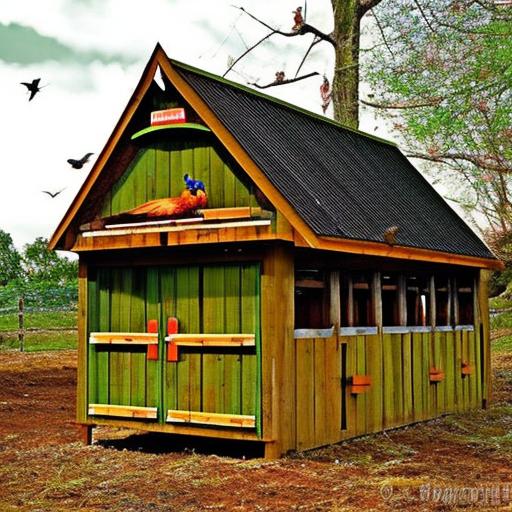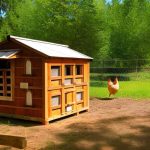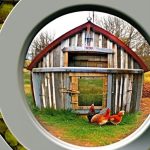A large chicken coop is a spacious and comfortable shelter for your flock of chickens. It provides ample space for them to move around, roost, and lay eggs. Unlike smaller coops, a large chicken coop allows for better ventilation, reduces stress and aggression among chickens, and promotes overall health and well-being. In this article, we will explore the benefits of a large chicken coop, factors to consider before building one, design ideas for maximum comfort and safety, the importance of ventilation and lighting, creative use of recycled materials, incorporating greenery and natural elements, innovative coop features for easy maintenance and cleaning, adding entertainment and enrichment for happy hens, coop security measures to protect your flock, and the importance of building a large chicken coop for a healthy and happy flock.
Benefits of a Large Chicken Coop for Happy Hens
1. More space for chickens to move around: A large chicken coop provides ample space for your chickens to move around freely. This is important as it allows them to exercise their muscles, stretch their wings, and engage in natural behaviors such as scratching the ground and dust bathing. When chickens have enough space to roam, they are less likely to become bored or stressed.
2. Reduced stress and aggression among chickens: Overcrowding in a small coop can lead to stress and aggression among chickens. When chickens are cramped together in a small space, they may peck at each other or engage in aggressive behavior. A large chicken coop reduces the likelihood of such behavior by providing enough space for each chicken to establish its own territory.
3. Increased egg production: A large chicken coop can have a positive impact on egg production. When chickens have enough space to move around and feel comfortable in their environment, they are more likely to lay eggs regularly. Additionally, reduced stress levels can also contribute to increased egg production.
4. Better overall health for chickens: A large chicken coop promotes better overall health for chickens. With ample space, chickens are less likely to develop respiratory issues or other health problems that can arise from overcrowding. They also have more opportunities to engage in natural behaviors, which can contribute to their physical and mental well-being.
Factors to Consider Before Building a Large Chicken Coop
Before building a large chicken coop, there are several factors that you need to consider:
1. Available space: Assess the available space in your backyard or farm to determine the size of the coop you can build. Make sure there is enough room for the coop and an outdoor run for your chickens to roam.
2. Number of chickens: Consider the number of chickens you have or plan to have in the future. Each chicken should have at least 4 square feet of indoor space and 10 square feet of outdoor space.
3. Climate and weather conditions: Take into account the climate and weather conditions in your area. If you live in an area with extreme temperatures, you may need to insulate the coop or provide additional heating or cooling options.
4. Budget: Determine your budget for building a large chicken coop. Consider the cost of materials, labor (if applicable), and any additional features or accessories you may want to include.
Coop Design Ideas for Maximum Comfort and Safety
When designing a large chicken coop, there are several factors to consider for maximum comfort and safety:
1. Choosing the right materials: Select durable and weather-resistant materials for your coop. Common options include wood, metal, or plastic. Ensure that the materials are safe for chickens and easy to clean.
2. Proper insulation: Insulate the coop to regulate temperature and protect your chickens from extreme weather conditions. This can be done by using insulation panels or adding extra layers of insulation.
3. Adequate ventilation: Proper ventilation is crucial for maintaining good air quality inside the coop and preventing respiratory issues. Install windows, vents, or fans to ensure a constant flow of fresh air.
4. Safe flooring options: Choose flooring materials that are easy to clean and provide good traction for chickens. Options include concrete, linoleum, or rubber mats. Avoid using materials that can harbor bacteria or cause injuries, such as wire mesh.
5. Nesting boxes and roosting bars: Provide enough nesting boxes for your hens to lay their eggs comfortably. Each nesting box should be at least 12 inches square. Install roosting bars at different heights to accommodate all your chickens.
The Importance of Ventilation and Lighting
Proper ventilation and lighting are essential for the health and well-being of your chickens:
1. Proper ventilation to prevent respiratory issues: Good ventilation helps remove excess moisture, ammonia, and odors from the coop. This is important as poor air quality can lead to respiratory issues in chickens. Ensure that there are enough windows, vents, or fans to allow for proper airflow.
2. Natural lighting for egg production and overall health: Chickens require natural light to regulate their internal clocks and stimulate egg production. Ensure that the coop has windows or skylights to allow natural light to enter during the day. If natural light is limited, consider installing artificial lighting to supplement it.
Creative Use of Recycled Materials in Coop Building
Using recycled materials in coop building has several benefits:
1. Benefits of using recycled materials: Using recycled materials is environmentally friendly and reduces waste. It also saves money as recycled materials are often cheaper than new ones. Additionally, repurposing materials adds a unique and creative touch to your coop design.
2. Examples of recycled materials that can be used in coop building: Old pallets can be used to build walls or flooring. Scrap metal can be repurposed as roofing material or fencing. Unused PVC pipes can be turned into feeders or waterers. Get creative and explore different options to incorporate recycled materials into your coop design.
Incorporating Greenery and Natural Elements in the Coop
Adding greenery and natural elements to the coop can have several benefits:
1. Benefits of adding greenery to the coop: Plants provide shade, improve air quality, and create a more natural and aesthetically pleasing environment for chickens. They also attract insects and other small creatures that chickens can forage on.
2. Examples of plants that are safe for chickens: Some safe plants for chickens include herbs like mint, basil, and oregano, as well as edible flowers like marigolds and nasturtiums. Avoid toxic plants such as lilies, daffodils, or azaleas, as they can be harmful to chickens if ingested.
Innovative Coop Features for Easy Maintenance and Cleaning
Incorporating innovative features into your coop design can make maintenance and cleaning easier:
1. Easy-to-clean flooring options: Choose flooring materials that are easy to clean and sanitize. Consider using removable trays or litter boxes under roosting bars for easy waste removal.
2. Automatic watering and feeding systems: Install automatic watering and feeding systems to ensure a constant supply of fresh water and food for your chickens. This saves time and reduces the risk of contamination.
3. Built-in storage for supplies: Include built-in storage areas in your coop design to store supplies such as feed, bedding, and cleaning tools. This keeps everything organized and easily accessible.
Adding Entertainment and Enrichment for Happy Hens
Providing entertainment and enrichment for your chickens has several benefits:
1. Benefits of providing entertainment and enrichment for chickens: Chickens are intelligent animals that require mental stimulation to prevent boredom and behavioral issues. Providing toys, perches, or hanging treats can keep them entertained and engaged.
2. Examples of toys and activities for chickens: Hang a mirror in the coop for chickens to peck at and interact with their reflection. Provide hanging treats or puzzle feeders to encourage foraging behavior. Install perches or swings for chickens to roost or play on.
Coop Security Measures to Protect Your Flock
Protecting your flock from predators is crucial for their safety:
1. Importance of protecting chickens from predators: Predators such as raccoons, foxes, or hawks can pose a threat to your chickens. Ensure that the coop is secure and predator-proof to prevent any harm to your flock.
2. Examples of security measures for the coop: Use sturdy fencing or wire mesh to enclose the coop and run area. Install locks or latches on doors and windows to prevent unauthorized access. Consider adding motion-activated lights or alarms to deter predators.
Building a Large Chicken Coop for a Healthy and Happy Flock
In conclusion, building a large chicken coop is essential for the health and happiness of your flock. It provides more space for chickens to move around, reduces stress and aggression, increases egg production, and promotes better overall health. Before building a large chicken coop, consider factors such as available space, the number of chickens, climate conditions, and budget. Design the coop with maximum comfort and safety in mind, incorporating features such as proper insulation, adequate ventilation, safe flooring options, nesting boxes, and roosting bars. Pay attention to ventilation and lighting to prevent respiratory issues and promote egg production. Get creative by using recycled materials and incorporating greenery into the coop design. Consider innovative features for easy maintenance and cleaning, provide entertainment and enrichment for happy hens, and implement security measures to protect your flock from predators. By building a large chicken coop that meets the needs of your flock, you are ensuring their health, happiness, and well-being.
Meet Walter, the feathered-friend fanatic of Florida! Nestled in the sunshine state, Walter struts through life with his feathered companions, clucking his way to happiness. With a coop that’s fancier than a five-star hotel, he’s the Don Juan of the chicken world. When he’s not teaching his hens to do the cha-cha, you’ll find him in a heated debate with his prized rooster, Sir Clucks-a-Lot. Walter’s poultry passion is no yolk; he’s the sunny-side-up guy you never knew you needed in your flock of friends!







